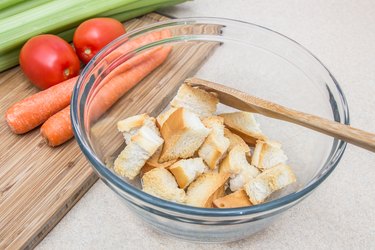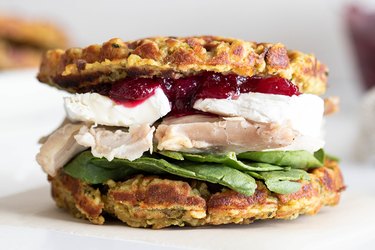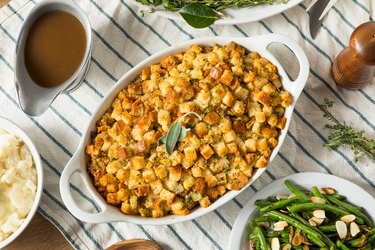
One of the best things about Thanksgiving dinner? The side dishes, of course! Candied sweet potatoes, cranberry sauce, mashed potatoes, green bean casserole... But for many, stuffing reigns supreme!
You can buy a passable version in a box, but if you ask us, homemade stuffing simply tastes better. Whether you plan to use a classic stuffing recipe or improvise your own, you might have a few questions about how to best prepare, store and serve stuffing. Never fear! With our FAQs and expert answers, you can step up your stuffing game in a snap.
Video of the Day
Video of the Day
Tip
If you’re a “wing it” kind of cook, you won’t need a formal recipe for stuffing. The basic procedure is pretty simple: preheat oven, melt butter in a large skillet (you can use oil if you prefer, but you’ll lose the buttery flavor), add aromatic vegetables and cook until soft. Turn off the skillet, get out prepared broth and mince herbs if you’re using the fresh kind. Toss dried bread cubes with prepared broth. (Some recipes call for 1 or 2 large eggs beaten into the broth, but those are optional.) Then add herbs and aromatics and toss again. Pack the stuffing into bird or (preferably) a baking dish and you’re off to the races.
If you’re more of a recipe person, check out our classic bread stuffing recipe or try our make-ahead bread stuffing. A bit of trial and error will quickly reveal whether you favor the traditional style or something more unconventional. After all, the best stuffing is the one you like the most!
1. Do I need stale bread to make stuffing?
Ever notice that your Grandma's stuffing recipe calls for stale bread? Here's the reason: Food in the 21st century is pretty cheap by historical standards. But our ancestors were generally a frugal bunch ("Waste not, want not!") who didn't believe in throwing out food. Stale bread was often around and using it up in the form of breadcrumbs or bread stuffing was one way to keep it from going to waste.
Today you can use genuinely stale bread, but you're better off to start with bread that's no more than a few days old. Dry it by spreading the diced loaf of bread on a baking sheet overnight, stirring regularly, or baking it in the oven at a very low temperature. It will still get dry enough to hold together when baked, but it won't taste stale.
2. What kind of bread should I use to make stuffing?
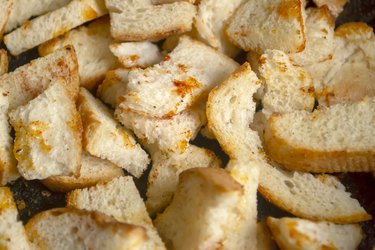
This is a "whatcha got?" kind of question. You can use ordinary old white bread—the standard sliced supermarket sandwich bread—or artisanal whole-grain, sourdough, crusty Italian or French bread from your local bakery. There are pre-seasoned loaves baked especially for stuffing (but you can do better seasoning on your own). In some families, it's traditional to use cornbread instead of regular bread. They'll all work just fine!
The standard technique is to dice a loaf into bread cubes of reasonably uniform size, but that's not mandatory. You can simply tear apart bread with your fingers to shorten prep time. Once you've done that, dry it until you're ready to begin making the stuffing.
Wait... What's the Difference Between Stuffing and Dressing?
Did you grow up calling it stuffing or dressing? The name often comes down to local custom, or even your own family’s tradition, but there is a distinction. Properly speaking, it’s stuffing if you cook it in the bird—but it's dressing if you prepare it separately in a baking dish.
Cooking your turkey stuffing inside the bird is no longer recommended (we’ll circle back to that in a moment), but for the purpose of this discussion, we’ll call it all stuffing.
3. Can I use dried herbs for stuffing?
Fresh herbs will certainly give you a brighter, higher-impact flavor. That said, you can make excellent dressing with dried herbs too. Just make sure dried herbs are also, well, fresh! If you can't remember when you bought those jars of herbs, they probably don't have much flavor left. A lot of us do our scratch cooking and baking for the year when the holiday season rolls around, so it's a good time to stock up on fresher herbs and spices. Whole spices or flaked herbs will hold flavor longer than their ground equivalents.
As for which herbs to use, the classics—fresh sage, thyme, rosemary—are always good, though you can "cheat" and use commercial poultry seasoning. Summer savory is an interesting option, sort of a flavor mix of thyme and mint with a bit of a peppery bite. Most recipes also suggest sautéing aromatics such as yellow onions, celery, carrots or garlic to dress up the stuffing, along with salt and pepper.
If your family is open to experimentation, try a less traditional stuffing that leans in a sweet or fruity direction with citrus zest, cranberries, diced apples or dried fruit. Alternatively, you might double down on savory flavors by adding cooked sausage crumbles to stuffing or going totally old-school with oyster stuffing. You do you!
4. What kind of broth should I use to make stuffing?

Turkey broth is best, but chicken broth or even vegetable broth will do in a pinch.
Getting the amount of broth right is important: You don't want stuffing to be dry or soggy, just well-moistened. Start by placing bread into a large bowl, then add about a cup of broth for every 4 cups of dried bread. Toss gently and let sit for a few minutes to absorb liquid. If the bread doesn't feel fully moistened, add more. If there's broth pooling in the bottom of the bowl, pour out excess. Then you can add herbs and sautéd aromatic veggies and give the whole mixture a good toss to combine.
Tip
Holiday meal prep can be pretty stressful if you’re doing it all on the day of, so it’s only sensible to make ahead whenever possible. For stuffing, advance prep can include drying bread, making sure you have enough broth, sautéing aromatic vegetables and pre-cooking ingredients such as bacon, sausage or oysters (then refrigerating).
Don’t combine wet and dry ingredients until you’re ready to cook stuffing and/or turkey.
5. Why shouldn't stuffing be cooked in the bird?
The traditional image of Thanksgiving dinner is a big, golden-brown bird with stuffing spilling out. In practice, that's problematic—if the stuffing is inside the bird, it's going to absorb a lot of raw turkey juice. Now you're committed: You have to cook the stuffing until it reaches a food-safe temperature.
The problem is that the turkey itself will be fully cooked before the stuffing is done. You get to choose between an overcooked bird with food-safe stuffing or a perfectly cooked bird with stuffing that might make everyone sick. That's why the USDA recommends cooking stuffing outside the bird, preferably in a casserole dish or slow cooker (which has the advantage of not taking up additional oven space). It won't give you that classic Norman Rockwell moment at the table, but it's a lot more practical.
6. Is there a food-safe way to cook the stuffing inside the bird if I really want to?
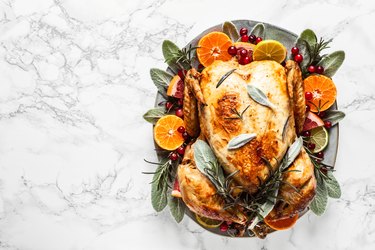
Yes! Mix up stuffing just before you use it, but pack it loosely into the bird—better yet, fill the cavity only 1/2 to 2/3 full to allow for air circulation—and roast at a temperature no lower than 325°F. Use an instant-read thermometer to check that the stuffing reaches a food-safe temperature of 165°F in the middle. The turkey will likely still be somewhat past its ideal doneness, but leaving a bit of space for air circulation will help significantly. And if your bird is a bit dry, you can always compensate with extra gravy.
You can also precook stuffing before adding it to the bird, if you like. Again, don't pack it in; leave some room for air to circulate. This way, when your turkey is ready to come out of the oven, the stuffing should also be ready. Just to be on the safe side, use that instant-read thermometer to check the stuffing's temperature at the end of cook time. If necessary, it can be scooped out into another dish and put into the oven to cook for a few minutes longer (and, ideally, get a crispy toasted layer on top).
7. How do I store leftover stuffing?

Because stuffing is full of turkey juices or broth, you need to treat it like any other perishable leftovers. Don't let it sit out for any more than 2 hours before packing it up in a suitable container and putting it into the fridge. Use it or freeze it within 3 or 4 days once it's refrigerated. If frozen, it can last three months—even longer if it's vacuum-sealed.
If you're going to eat your leftover stuffing as is, you'll need to reheat it to an internal temperature of 165°F—as you would for any other leftovers—to ensure food safety. If leftover stuffing is dry, moisten it with a bit of extra turkey broth or chicken stock so it'll reheat properly.
8. What can I make with leftover stuffing?
There are literally thousands of interesting things to do with leftover stuffing. If you have family staying over, for example, put leftover stuffing into a baking dish with lots of beaten eggs and some sausages, top with cheese and bake a savory breakfast casserole. Use stuffing as the top crust on a turkey pot pie, as the bread element in meatballs or meatloaf, toasted as seasoned croutons for salads, stuffed inside peppers or squash... The (delicious) list continues!
With these tips and tricks for flavor, freshness, storage and more, you'll be making spectacular stuffing for Thanksgiving, Christmas and beyond. Dig in!
